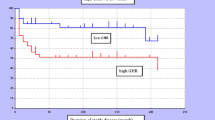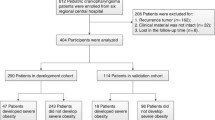Abstract
Objective
Some patients with paediatric craniopharyngiomas (PCs) showed normal growth despite growth hormone deficiency, which is known as growth without GH (GWGH); however, its mechanism remains unclear. We aimed to develop a novel clinical score to predict the probability of GWGH in PCs.
Methods
A total of 708 PC patients were prospectively enrolled from six hospitals, among which 431 patients were finally included. Data from four of the six hospitals (n = 325) were used to develop the innovative clinical score (ICS), which was further validated using the data from the other two hospitals (n = 106). To establish and validate the ICS, sequential logistic regression was used to analyse the clinical characteristics including tumour growth pattern and tumour size and so on. Furthermore, C-statistic was employed to calibrate the discriminatory ability of the established clinical score, while a calibration plot was adopted for further assessment.
Results
The overall incidence of GWGH was 16.9% (73/431). The ICS ranged from 2 to 23, with an optimism-corrected C-statistic of 0.820, Furthermore, the optimism-corrected C-statistic of external validation was 0.835, indicating good discriminatory power and robustness of the clinical score. Additionally, no apparent overestimation or underestimation was observed in the calibration plots, which showed excellent calibration power of the clinical score.
Conclusions
Based on tumour growth patterns and PC patients’ clinical characteristics, individualized surgical strategies were promising to achieve long-term effective management of PC patients. The ICS is valuable for the evaluation of probability of developing postoperative GWGH.
Clinical trial registration
ClinicalTrials.gov ID: NCT00949156.




Similar content being viewed by others
References
Qi S, Lu Y, Pan J, Zhang X, Long H, Fan J (2011) Anatomic relations of the arachnoidea around the pituitary stalk: relevance for surgical removal of craniopharyngiomas. Acta Neurochir (Wien) 153:785–796
Müller HL (2019) Management of endocrine disease: childhood-onset craniopharyngioma: state of the art of care in 2018. Eur J Endocrinol. https://doi.org/10.1530/EJE-18-1021
Qi S, Pan J, Lu Y, Gao F, Cao Y, Peng J, Zhang X (2012) The impact of the site of origin and rate of tumour growth on clinical outcome in children with craniopharyngiomas. Clin Endocrinol (Oxf) 76:103–110
Bucher H, Zapf J, Torresani T, Prader A, Froesch ER, Illig R (1983) Insulin-like growth factors I and II, prolactin, and insulin in 19 growth hormone-deficient children with excessive, normal, or decreased longitudinal growth after operation for craniopharyngioma. N Engl J Med 309:1142–1146
Lazar L, Dan S, Phillip M (2003) Growth without growth hormone: growth pattern and final height of five patients with idiopathic combined pituitary hormone deficiency. Clin Endocrinol (Oxf) 59:82–88
Iwayama H, Kamijo T, Ueda N (2011) Hyperinsulinemia may promote growth without GH in children after resection of suprasellar brain tumors. Endocrine 40:130–133
Pavlou M, Tsatsoulis A, Efstathiadou Z, Bitsis S, Papadopoulou ZL (2001) A study of the growth-promoting and metabolic effects of growth hormone (GH) in a patient with the “growth without GH” syndrome. Growth Horm IGF Res 11:225–230
Lee SS, Han AL, Ahn MB, Kim SH, Cho WK, Cho KS, Park SH, Jung MH, Suh BK (2017) Growth without growth hormone in combined pituitary hormone deficiency caused by pituitary stalk interruption syndrome. Ann Pediatr Endocrinol Metab 22:55–59
Liu Y, Qi ST, Wang CH, Pan J, Fan J, Peng JX, Zhang X, Bao Y, Liu YW (2018) Pathological relationship between adamantinomatous craniopharyngioma and adjacent structures based on QST classification. J Neuropathol Exp Neurol 77:1017–1023
Pan J, Qi S, Liu Y, Lu Y, Peng J, Zhang X, Xu Y, Huang GL, Fan J (2016) Growth patterns of craniopharyngiomas: clinical analysis of 226 patients. J Neurosurg Pediatr 17:418–433
Grimberg A, DiVall SA, Polychronakos C, Allen DB, Cohen LE, Quintos JB, Rossi WC, Feudtner C, Murad MH (2016) Guidelines for growth hormone and insulin-like growth factor-I Treatment in children and adolescents: growth hormone deficiency, idiopathic short stature, and primary insulin-like growth factor-I deficiency. Horm Res Paediatr 86:361–397
Murray RO (1976) Assessment of skeletal maturity and prediction of adult height (TW2 method). Proc R Soc Med 69:542
Oto Y, Matsubara K, Ayabe T, Shiraishi M, Murakami N, Ihara H, Matsubara T, Nagai T (2018) Delayed peak response of cortisol to insulin tolerance test in patients with Prader–Willi syndrome. Am J Med Genet A 176:1369–1374
Koulouri O, Auldin MA, Agarwal R, Kieffer V, Robertson C, Falconer Smith J, Levy MJ, Howlett TA (2011) Diagnosis and treatment of hypothyroidism in TSH deficiency compared to primary thyroid disease: pituitary patients are at risk of under-replacement with levothyroxine. Clin Endocrinol (Oxf) 74:744–749
Zong XN, Li H (2013) Construction of a new growth references for China based on urban Chinese children: comparison with the WHO growth standards. PLoS One 8:e5969
Xu S, Gu X, Pan H, Zhu H, Gong F, Li Y, Xing Y (2010) Reference ranges for serum IGF-1 and IGFBP-3 levels in Chinese children during childhood and adolescence. Endocr J 57:221–228
Halbreich U, Kinon BJ, Gilmore JA, Kahn LS (2003) Elevated prolactin levels in patients with schizophrenia: mechanisms and related adverse effects. Psychoneuroendocrinol 28:53–67
Collins GS, Reitsma JB, Altman DG, Moons KG (2015) Transparent reporting of a multivariable prediction model for individual prognosis or diagnosis (TRIPOD): the TRIPOD statement. Br J Surg 102:148–158
Sullivan LM, Massaro JM, D’Agostino RB (2004) Presentation of multivariate data for clinical use: the Framingham Study risk score functions. Stat Med 23:1631–1660
Cook NR (2008) Statistical evaluation of prognostic versus diagnostic models: beyond the ROC curve. Clin Chem 54:17–23
Hosmer DW Jr, Lemeshow S, Sturdivant RX (2013) The multiple logistic regression model. Applied logistic regression, 3rd edn. Wiley, New York
Olsson DS, Andersson E, Bryngelsson IL, Nilsson AG, Johannsson G (2015) Excess mortality and morbidity in patients with craniopharyngioma, especially in patients with childhood onset: a population-based study in Sweden. J Clin Endocrinol Metab 100:467–474
Qi S, Peng J, Pan J, Zhang X, Lu Y, Fan J, Huang G (2013) Growth and weight of children with craniopharyngiomas based on the tumour location and growth pattern. J Clin Neurosci 20:1702–1708
Müller HL, Emser A, Faldum A, Bruhnken G, Etavard-Gorris N, Gebhardt U, Oeverink R, Kolb R, Sörensen N (2004) Longitudinal study on growth and body mass index before and after diagnosis of childhood craniopharyngioma. J Clin Endocrinol Metab 89:3298–3305
Yaşargil MG, Curcic M, Kis M, Siegenthaler G, Teddy PJ, Roth P (1990) Total removal of craniopharyngiomas. Approaches and long-term results in 144 patients. J Neurosurg 73:3–11
Steno J, Malácek M, Bízik I (2004) Tumor-third ventricular relationships in supradiaphragmatic craniopharyngiomas: correlation of morphological, magnetic resonance imaging, and operative findings. Neurosurgery 54:1051–1058
Kassam AB, Gardner PA, Snyderman CH, Carrau RL, Mintz AH, Prevedello DM (2008) Expanded endonasal approach, a fully endoscopic transnasal approach for the resection of midline suprasellar craniopharyngiomas: a new classification based on the infundibulum. J Neurosurg 108:715–728
Pinto G, Bussières L, Recasens C, Souberbielle JC, Zerah M, Brauner R (2000) Hormonal factors influencing weight and growth pattern in craniopharyngioma. Horm Res 53:163–169
Geffner ME (1996) The growth without growth hormone syndrome. Endocrinol Metab Clin North Am 25:649–663
Giustina A, Mazziotti G, Canalis E (2008) Growth hormone, insulin-like growth factors, and the skeleton. Endocr Rev 29:535–559
Weinzimer SA, Homan SA, Ferry RJ, Moshang T (1999) Serum IGF-I and IGFBP-3 concentrations do not accurately predict growth hormone deficiency in children with brain tumours. Clin Endocrinol (Oxf) 51:339–345
Hibi I, Tanaka T, Tanae A, Kagawa J, Hashimoto N, Yoshizawa A, Shizume K (1989) The influence of gonadal function and the effect of gonadal suppression treatment on final height in growth hormone (GH)-treated GH-deficient children. J Clin Endocrinol Metab 69:221–226
Arroyo A, Pernasetti F, Vasilyev VV, Amato P, Yen SS, Mellon PL (2002) A unique case of combined pituitary hormone deficiency caused by a PROP1 gene mutation (R120C) associated with normal height and absent puberty. Clin Endocrinol (Oxf) 57:283–291
Acknowledgements
The authors thank Duan Chongyang, MD, Xu Hai-yan, RN, Qiu xiao-yu, RN, Wang Hai, MD, and Fan Jun, MD for the collection of data and care of patients enrolled in this study.
Funding
This research received grant from four fund projects in the public, including Science and Technology Program of Guangdong (No. 2017A020215048) and the Natural Science Foundation of Guangdong Province (No. 2019A1515012140), and Clinical Research Startup Program of Southern Medical University by High-level University Construction Funding of Guangdong Provincial Department of Education (LC2016YM001).
Author information
Authors and Affiliations
Corresponding authors
Ethics declarations
Conflict of interest
We declare that we have no other financial and personal relationships with other people or organizations that can inappropriately influence our work, there is no professional or other personal interest of any nature or kind in any product, service and/or company that could be construed as influencing the position presented in, or the review of, the manuscript entitled “Development of a Novel Score to Predict Probability of Growth without Growth Hormone after Resection of Pediatric Craniopharyngiomas: Relative to Tumor Growth Pattern”. All the work is original, Neither the entire paper nor any part of its content has been published, submitted or accepted elsewhere, which has been approved by all authors.
Ethical approval
All procedures performed in studies involving human participants were approved by the ethics committee at the Nanfang Hospital, Southern Medical University (SMU) and its later amendments or comparable ethical standards.
Informed consent
Informed consent was obtained from all individual participants included in the study.
Additional information
Publisher's Note
Springer Nature remains neutral with regard to jurisdictional claims in published maps and institutional affiliations.
Rights and permissions
About this article
Cite this article
Peng, J.X., Yang, L., Huang, G.L. et al. Development of a novel score to predict probability of growth without growth hormone after resection of paediatric craniopharyngiomas: relative to tumour growth pattern. J Endocrinol Invest 43, 737–747 (2020). https://doi.org/10.1007/s40618-019-01154-y
Received:
Accepted:
Published:
Issue Date:
DOI: https://doi.org/10.1007/s40618-019-01154-y




